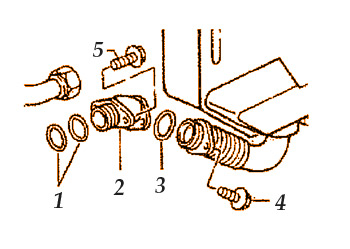Affected Vehicle: 911 Turbo (996), as of 2001(1)
Information: Due to the low position of the turbo-chargers, a non-return (check) valve is installed between the oil tank and the engine (see Fig. 1, item 2). This prevents the oil tank from emptying into the crankcase when the engine is turned off. 
In certain cases, this valve could stick in the closed position, preventing the flow of oil from the oil tank to the engine. As of May 18, 2000, a modified non-return (check) valve is being installed from engine number M96/70 – 64 1 01282. The new part is identified by a light blue paint dot.
Caution: Possible engine damage due to the lack of lubrication!
• Shut off engine immediately.
• Do not attempt to find the cause with the engine running.
Service Procedure:
Replacing the non-return valve.
1. Drain the oil into a clean container.
2. Loosen the oil tank mounting bolts.
3. Remove the two M6x16 hexagon socket head bolts, which secure the tank to the check valve (see Fig.1, item 4).
4. Remove the M8x30 pan-head bolt securing the check valve to the engine (see Fig. 1, item 5).
5. Carefully pull the tank back at the bottom.
6. Turn and guide the non-return valve out of the engine and oil tank (see Fig. 1, item 2).
7. Reverse the procedure to install the new valve.
Courtesy of Identifix.













